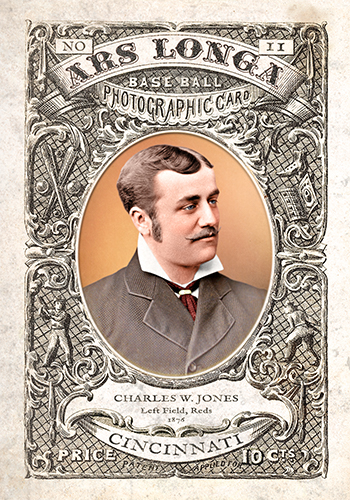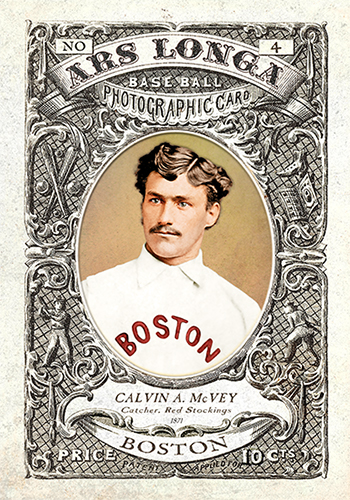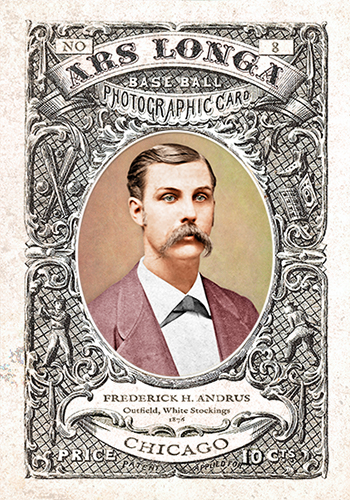
- Series: Mort's Reserve
- City: Chicago
- Team: White Stockings
- League: National League
Frederick Hotham Andrus (1850-1937) had the distinction of making major league baseball a part time occupation. Fred always held gainful employment but stayed close enough to the game to get two opportunities to play at the pinnacle of the sport, both with Chicago. His first brief tour was in 1876 where he played outfield in eight games for the champion White Stockings in the National League's inaugural season. He made a good record, hitting .306 in 36 plate appearances with three doubles and two RBI. Eight years later Andrus returned for a single game for the White Stockings, this time as a pitcher. He completed his start while yielding three runs, two earned, for a “career” ERA of 2.00. Andrus is known to have played for only one official minor league club, Milwaukee of the League Alliance, in 1877. He was one of two managers for the team that year along with Pidgey Morgan. Milwaukee was one of 29 teams vying in the agglomeration known as the League Alliance. It had formed in response to a perceived threat by a rival professional organization, the International Association of Professional Base Ball Players challenging William Hulbert's new National League. Spalding had managed Andrus at Chicago in '76 and was heavily involved with Hulbert in navigating the tumult as the nascent NL established itself as THE major league. In fact, Spalding had founded his famed sporting goods company in 1876, a franchise Andrus would serve as treasurer for eight years beginning with his move to Chicago in 1884. Undoubtedly, it was the high-level connections Andrus had forged in baseball and in business that gave him the entree for his cameo appearance that year back with his old Windy City team.
- Andrus had started out in his native Michigan playing for the Mutuals of Jackson, possibly a successor to one of the earliest organized clubs in America. The Daybreak Club of Jackson had begun in 1860. Jackson had another claim to fame as, in 1854, a meeting “Under the Oaks” just outside of town was the site of the founding of the Republican Party
- Fred left Spalding's company to manage a Detroit real estate concern with which he was still employed at his death from pneumonia at age 87

- Series: Mort's Reserve
- City: Boston
- Team: Red Stockings (NAPBBP)
- League: National Association (NAPBBP)
Charles Roscoe Barnes (1850-1915) was the best player in the five year history of the fist professional baseball league, the National Association of Professional Baseball Players (NAPBBP), 1871-1875. Barnes is the all-time NAPBBP leader in runs, hits, doubles, walks, stolen bases, total bases, batting average, OBP and SLG%. He then dominated the National League in its inaugural year, 1876, leading the league hits, runs, average, OBP, SLG%, total bases, doubles, triples and walks. He also hit the 1st HR in National League history, for the Chicago White Stockings, 5.2.1876. Over the first six years of his major league career, Barnes' batting average was .397. An unidentified illness limited Barnes to just 22 games in 1877, and he was never the same player again, retiring shortly thereafter at the age of 31.
“Roscoe C. Barnes…was the greatest second baseman the game ever had…” - A History of the Boston Baseball Club, 1897.
"No matter how great you were once upon a time — the years go by, and men forget. Ross Barnes, forty years ago, was as great as Cobb or Wagner ever dared to be. Had scores been kept then as now, he would have seemed incomparably marvelous.” - W.A. Phelan, Baseball Magazine, 1915
- Because he played in the second game in MLB history, is credited with the 17 other players that day as the 27th player to debut in MLB
- 1st hitter to win batting titles in 2 leagues: NA in ’72-73 and NL in ‘76
- In 1918, made Cap Anson’s all-time team as the shortstop
- Barnes was selected as SABR’s ”Overlooked 19th Century Baseball Legend “ for 2013
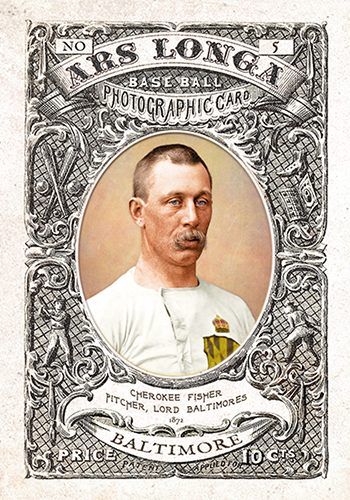
- Series: Mort's Reserve
- City: Baltimore
- Team: Canaries
- League: National Association (NAPBBP)
William Charles Fisher (1844-1912) was an erratic pitcher in baseball’s earliest days. He set some records with his renowned fastball but ended his career with far more losses than wins (56-84). Fisher toiled for so many clubs in the sport's beginnings that his resume reads like a catalog of the founding franchises. In the amateur days of the late 1860s, Cherokee threw for the West Philadelphias, the Cincinnati Buckeyes, the Troy Haymakers and the Chicago Dreadnaughts. As baseball turned pro, Fisher made the rounds, first with the Rockford Forest Citys in 1871 and then with such noteworthy teams as the Baltimore Canaries, Philladelphia Athletics and White Stockings, Hartford Dark Blues, Cincinnati Reds and Providence Grays. He posted the National Association’s best ERA in ‘72, 1.80, with Baltimore. Another less illustrious moment came with Chicago’s White Stockings in 1876, the first season for the new National League, when Cherokee surrendered the first home run in league history to Ross Barnes. Despite his mediocre win/loss record, Fisher ended his career with a fine 2.61 ERA. His finale came with Providence in ‘78 where his dismal 4-21 record ushered him out of the big leagues. Even then he managed a 3.06 ERA. It has been asserted that Fisher struggled throughout his tenure in baseball with a severe drinking problem. While that was a common affliction in his day, his history indicates he wasn’t out of control as he served for many years with the Chicago Fire Department following his major league days. Fisher’s peripatetic ways have been cited as a product of his alcoholism, but players were chattel in those days and clubs could and did ship even good players around arbitrarily.
- Fisher was 10-1 with Baltimore for his best winning percentage. His most wins came with Philadelphia in 1875 when he won 22 while losing 19. This was also the only other season he posted a winning record
- A quote concerning Fisher’s victory over New Haven in May of 1875 is a reminder of the far different conditions that prevailed in the early days: “Fisher’s pitching seemed to bother the New Haveners some, and foul outs and outs on strikes were frequent” per the New Haven Register
- Series: Mort's Reserve
- City: Boston
- Team: Red Stockings (NAPBBP)
- League: National Association (NAPBBP)
Charles Harvey Gould (1847-1917) played for the 1st professional team, the Cincinnati Red Stockings, who reigned supreme for 2 yrs, winning 84 straight games and barnstorming the country from 1869-1870. Disbanded in ’71, Gould followed Harry Wright to Boston where he inaugurated baseball there and won its 1st title in 1872.
- His fielding prowess earned him the nickname “the bushel-basket”
- Ironically, Gould’s errant throw to 2nd ended his Red Stockings’ duel with the Brooklyn Atlantics, and with it the longest winning streak in baseball history on June 14, 1870
- Was Cincinnati Reds’ first manager: 1876
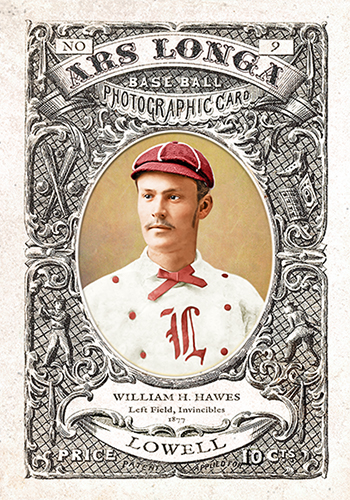
- Series: Mort's Reserve
- City: Lowell
- Team: Invincibles
- League: League Alliance
William Hildreth Hawes (1853-1940) was an infielder out of New England who had a chance to play briefly for Harry Wright in the early days of the National League, first in an 1876 exhibition match in Boston while Bill was with the Lowell club, followed by a stint with Wright’s Red Caps in 1879. It appears he made an impression during that early game that prompted Wright to give Hawes a shot in the outfield. The ‘76 game definitely made an impression on Hawes and his family as, many years later at the end of his long life, Hawes’ obituary included reference to that long ago contest, per the Lowell Evening Leader: “He played second base in Boston when the first professional game was played there in 1876.” Despite his New England roots, Hawes’ passion for baseball took him out west in 1883 when he and many fellow players joined the first recognized minor league, the Northwestern League. Bill signed with Saginaw that year and got his one other opportunity at the big leagues with the Union Association’s Cincinnati Outlaw Reds in ‘84. When the UA collapsed that season, Hawes returned home with Brockton in the new New England League. His team made it to a play-off with Lawrence that inaugural year but Lawrence prevailed in a best-of-three. The prairie beckoned once more and Hawes moved to the Twin Cities, with Minneapolis in 1887-88 and St. Paul for 1889-90. Once again Bill headed home after the 1890 season and went into business in Lowell. He continued to play occasionally with his pals in local leagues and was part of numerous reunions of the Bartlett Club of Lowell, his original squad from 1874-75.
- Hawes served as treasurer of the “Junior Baseball Players of Massachusetts 1873, 1874, and 1875 Association”
- Hawes overcame a weak stint at the plate for Wright’s Boston club where he hit a mere .200 by feasting a bit on Union Association pitching. He managed .278 with the Outlaws giving him an overall .254 average in the major leagues
- Hawes is represented fairly well in Goodwin's Old Judge series with six known poses of him suited up with the Minneapolis Millers in 1888. Although OJ cards exist with his name Hawes properly spelled, it appears that his name was misspelled as "Howes" on his cards more often than not.
- Hawes also appears on the 1879 Boston Red Caps' team composite cabinet, beside teammates Tommy Bond, Ezra Sutton, John Morrill, Jack Burdock and Harry Wright.
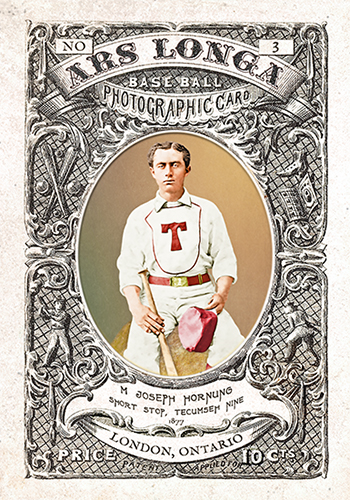
- Series: Mort's Reserve
- City: London
- Team: Tecumsehs
- League: International Association
Michael Joseph Hornung (1857-1931) made a lasting impression in the baseball world of his day on at least two grounds. Most noteworthy, he was perhaps the premier defensive outfielder of the 1880s. His sure-handedness allowed him to lead the National League in fielding percentage in 1881, ‘82, ‘83 and ‘86. The second basis of notoriety for Hornung was what must have been a very annoying habit. He would shout “ubbo, ubbo!” whenever he got a hit or made a play he fancied. Since he hit a respectable .257 over his twelve-year career, and made just about all the plays that came his way in the no-glove era, the ballparks of the day must have resounded with many an “ubbo.” His antics led to his nickname Ubbo Ubbo, which meant others beside himself were uttering the gibberish all too frequently.
Joe had begun his pro career in Canada with the London (Ontario) Tecumsehs in 1876. His major league debut was with the Buffalo Bisons in 1879 and in '81 made the move to Boston which would be his home through the 1888 season. The colorful star's performance declined and the Beaneaters tried to sell him to the White Stockings. The veteran balked, insisting on a piece of the $5000 price, and was rewarded by being ousted from the league. The American Association's Orioles welcomed Joe and he played one year on a bad leg before ending his big league career in 1890 with the Giants. His speed had been an asset afield and on the bases. Hornung was a renowned base-stealer, usually among the leaders in triples, and led the NL in scoring in 1883.
- Ubbo Ubbo's popularity was such that the vaunted '27 Yankees honored him on his June 12 birthday at the stadium. Ruth, Gehrig, Lazzeri and all serenaded Joe and he received a “nice check” from players who remembered him fondly as one of the greats.
- His hometown Utica paper hailed him as “King of the Left Fielders” and “just as much a baseball hero as Ty Cobb, Babe Ruth or Tris Speaker is today.”
- Series: Mort's Reserve
- City: Cincinnati
- Team: Reds (NL)
- League: National League
Charles Wesley Jones (1852-1911) was a star slugger in the NL and AA from 1875-88. Though he never led his teams to pennants, Jones held many early HR records, notably with Boston and Cincinnati. A victim of the Blacklist, Jones lost two seasons in his prime. Despite this, he was the career HR leader thru 1884.
- Was the first player to hit 2 HRs in same inning, 6/10/80. The pitcher was Tom Poorman
- Nickname: Baby
- Birth name: Benjamin Wesley Rippay
- Was the 274th player to debut in MLB
- Was an MLB umpire, 1890-1891
- According to Jay Jaffe's JAWS system, Charley ranks as the 80th best left fielder in MLB history, between Larry Hisle & Joe Rudi
- Until 2012 Jones was the best-known MLB player for whom death info was unknown. The “mystery” was solved by SABR researcher Greg Perkins.
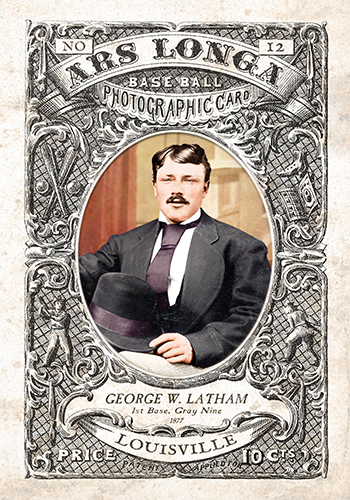
- Series: Mort's Reserve
- City: Louisville
- Team: Grays (NL)
- League: National League
George Warren Latham (1852-1914) came out of Utica, NY to become his hometown’s first player to make the major leagues. He began his career with a pretty good club, Harry Wright’s National Association champion Boston Red Stockings. They captured the pennant in 1875 with a 71-8 record. Juice (also known as Jumbo) got into only 16 of those games in ‘75, but he hit a solid .269 with 13 RBI. Latham also played for the New Haven Elm Citys that year, but hit only .197 as a utility infielder. Perhaps his stint with Wright gave him baseball smarts that quickly paid off as Jumbo also managed the Elm Citys for 18 of their games despite his rookie status. Latham fared much better with his next big league team, the Louisville Grays in the National League’s second season, 1877. He hit a fine .291 as a regular first baseman and had the most plate appearances on the club. A four year hiatus ensued before Juice revived his big league career in the American Association. He played for the Philadelphia Athletics in ‘82 and again had a solid season, batting .285, and was the team’s RBI leader with 38. The veteran moved back to Louisville with the AA’s Eclipse in 1883 and saw a drop-off in his stats, hitting .250 as the everyday first sacker. The following year would close-out his tenure in the majors, again with the Eclipse, where Juice slumped to .169 in his final summer at the top of his profession.
- Latham was far from through with baseball when he left Louisville. He enjoyed a minor league career that continued through the decade of the 1880s. He had played for Utica in the International League back in 1878 and would play for his hometown in 1886 and ‘87, as well as other Eastern League and International League teams
- Juice had shown further managerial skills with the London Tecumsehs of the International Association of Professional Base Ball Players back in 1877-78, a would-be rival to the new NL in the States. The Tecumsehs have been called the finest team in all of Canada in the early decades of the game
- Per the New York Times, Latham made a final appearance with the Richfield Springs, NY squad in 1894, just a short drive from Cooperstown - perhaps the closest Jumbo got to the Hall
- Series: Mort's Reserve
- City: Boston
- Team: Red Stockings (NAPBBP)
- League: National Association (NAPBBP)
Calvin Alexander McVey (1849-1926) was a key player in the earliest days of pro ball, first with Harry Wright’s seminal Cincinnati Red Stockings in 1869, then moving with Wright to Boston as one of Harry’s select threesome. The young McVey joined the fledgling pro team for a stagecoach trip to Omaha and then became the 1st ball club to use the new transcontinental railroad to SF as part of the Red Stocking’s national tour.
- During his career, McVey played all nine positions and was an outstanding hitter: .346 BA lifetime
- McVey’s move from Boston to Chicago in 1876 with Al Spalding, Ross Barnes & Deacon White (to form the White Stockings with Cap Anson, Paul Hines & Bob Addy) led to the creation of the NL
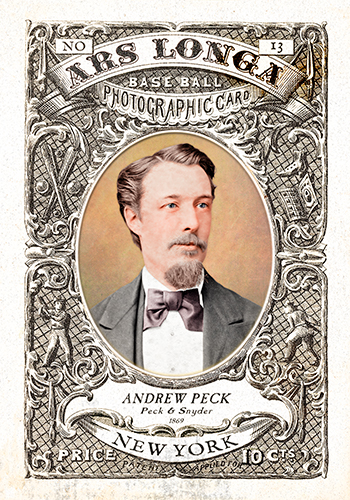
- Series: Mort's Reserve
- City: New York
Andrew Peck (1836-1918) and his partner Walter Irving Snyder founded the first true sporting goods store in 1866 at 124-128 Nassau Street in New York City. The pair wanted to promote their business and thought trade cards might help. In 1869, this was a common technique for many retailers, but Peck and Snyder wanted something distinctive. They came up with the idea of using the image of Harry Wright’s nationally renowned new professional baseball squad, the Cincinnati Red Stockings, as their motif. A few versions were printed, the most prized of which today features the players in uniform and their names below the photo. No one could have known that this modest marketing scheme would pave the way for one of the great products and hobbies in American history, as Peck and Snyder unwittingly established a framework for the mass-produced baseball picture card. Following the Red Stockings release, the company issued cards featuring the hometown Mutuals and rival Chicago White Stockings in 1870. Other manufacturers soon followed suit and baseball cards became an advertising mainstay.
- Peck posted inning-by-inning telegraph reports of the big game between the NY Mutuals and Wright’s club in 1870 to a fevered crowd of NY “cranks.” Final tally: Cincinnati 15, NY 12.
- Peck started his business with ten cents to his name and died a rich man
- Perhaps not rich enough to buy his own trade cards today though: a Peck & Snyder 1869 Cincinnati Red Stockings card recently sold for $75,000

- Series: Mort's Reserve
- City: Philadelphia
- Team: Athletics (NAPBBP)
- League: National Association (NAPBBP)
Alfred James Reach (1840-1928) “served baseball with distinction as player, organizer, club owner and provider of the equipment to attain the highest possible skill in the game” per his own Reach’s Official Base Ball Guide upon his death. “A good man, of the kindest impulses, his name will last as long as we have baseball” expressed the legacy of one of the great men of the early era of America’s game. The London-born, Brooklyn-raised Reach joked that he made the gloves he eschewed in the beginnings of the game in which he starred for the Brooklyn Eckfords and Philadelphia Athletics. He also made the AL’s balls while owning the NL Phillies franchise. A genius for marketing equipment and a lifelong love of the game made him one of the most influential figures of baseball’s first half-century.
- Began play in the amateur era, then founded the NL’s Philadelphia club in 1883
- Built the first modern ballpark in ’87, then rebuilt it with steel after a fire in ‘94
- Al's brother Bob Reach was an MLB shortstop for 3 games, 1872-1873
- Was the 88th player to debut in MLB
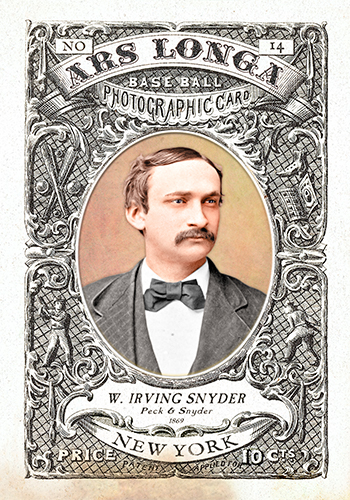
- Series: Mort's Reserve
- City: New York
Walter Irving Snyder and his partner Andrew Peck founded the first true sporting goods store in 1866 at 124-128 Nassau Street in New York City. The pair wanted to promote their business and thought trade cards might help. In 1869, this was a common technique for many retailers, but Peck and Snyder wanted something distinctive. They came up with the idea of using the image of Harry Wright’s nationally renowned new professional baseball squad, the Cincinnati Red Stockings, as their motif. A few versions were printed, the most prized of which today features the players in uniform and their names below the photo. No one could have known that this modest marketing scheme would pave the way for one of the great products and hobbies in American history, as Peck and Snyder unwittingly established a framework for the mass-produced baseball picture card. Following the Red Stockings release, the company issued cards featuring the hometown Mutuals and rival Chicago White Stockings in 1870. Other manufacturers soon followed suit and baseball cards became an advertising mainstay.
Snyder forged a fortuitous relationship with baseball-star-turned-entrepreneur Al Spalding. Irving joined the 1888 “Spalding’s World Tour” to help promote his business interests (and find a buyer for 30,000 pairs of roller skates, per Jerry Houseman of Sports Collectors Daily). The friendship with Spalding later led to Al buying out Peck and Snyder, allowing the founders to devote themselves to manufacturing.
- In a memoir of the ‘88 tour, Snyder wrote of playing the game for “about 200 Arabs” in the shadows of the pyramids. He was pleased to note that, unlike the English, the Egyptians never once referred to baseball as “really just Rounders, you know.”
- In the 1913 edition of Spalding’s “official base ball guide,” his old pal Snyder penned a promo: “I have read the book from cover to cover with great interest.”
- Snyder is credited by Aussie cricketer gear manufacturer BaggyCaps as having invented the cap cricketers proudly sport today, acknowledging it was created for baseball. Thus Irving helped bring full circle the influence of British “rounders” and America’s pastime
- A Peck & Snyder 1869 Cincinnati Red Stockings card recently sold for $75,000
Following in his older brother’s footsteps, Ward B. Snyder established a sporting goods store at 84 Fulton St. in New York City in 1875. The annually published Ward B. Snyder’s Illustrated Price List and Catalogue of Base Ball and Sportsmen’s Goods is a highly prized collectible today and is a fantastic color documentary of baseball uniforms and equipment of the 1870s.






